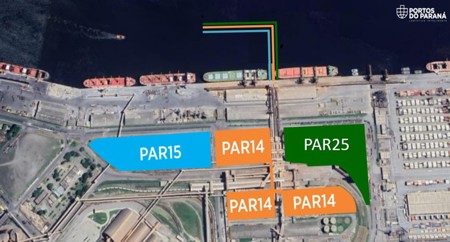
New Exportation Corridor at the Port of Paranaguá
Ports of Paraná
Historically, the Port of Paranaguá is one the largest grain exporting public ports in Brazil, along with Santos and Itaqui. Over the last years, Brazil has become the main exporting nation for soy beans and is the second largest exporter for corn. In order to increase their share even more, the Port Authority o fParanaguá has come up with a plan to modernize and expand port capacity: the construction of the new Export Corridor (COREX), which includes a new 'T'-shaped Pier, along with the expansion of conveyor belt capacities and loading equipment. The project aims to increase docking and cargo handling capacity, allowing for operations with larger and more efficient ships. The project is in an advanced phase, including engineering design, cost estimates, and the process of environmental licensing. The project is based on the premise that the conveyor belts of the new corridor will be fed by various conveyors coming from different terminal operators, thereby allowing the bulk cargo to be transported via conveyor belts across the access bridge, interconnected by transfer towers, The project is based on the premise that the belt conveyors of the new corridor will be fed by different conveyors coming from different port operator terminals, so that the bulk cargo would be transported by belts following the access bridge, interconnected by transfer towers, which allow the change of direction of solid bulk cargo, and unloaded onto ships by modern ship loading equipment. With a total area of approximately 21,000 m², the new civil structures of “Pier T” consist of an Access Bridge with an extension of approximately 251 m, connecting to the existing pier near berth 212, and a Mooring Pier with an extension of 695 m in length, consisting of 4 (four) berths, to serve Cape Size class vessels of up to 140,000 DWT. The electromechanical installations of the integral pier project consist of 8 (eight) Conveyor Belts, each with a capacity of 4,000 t/h, 6 (six) Transfer Towers and 16 (sixteen) Shiploaders, resulting in a capacity of 8,000 t/h per berth. Due to the unprecedented nature of the project, both in terms of the transport capacity involved for grains (4,000 t/h) and the system for enclosing these conveyors, the large length of the belts and the high power required, the shipping system will have the largest capacity in the country, in addition to its modernity. The total investment in the project is R$ 1 billion from the state government, plus another R$ 1.2 billion from the private sector, related to the lease of the terminals. The first phase of the work focuses on the construction of the bridge between the pier and two new berths (westbound), while the second phase completes the "T" with two more berths (eastbound). The project as a whole seeks to consolidate the Port of Paranaguá as a strategic logistics hub and a reference in the sector, taking Paranaguá to a new level in port development.